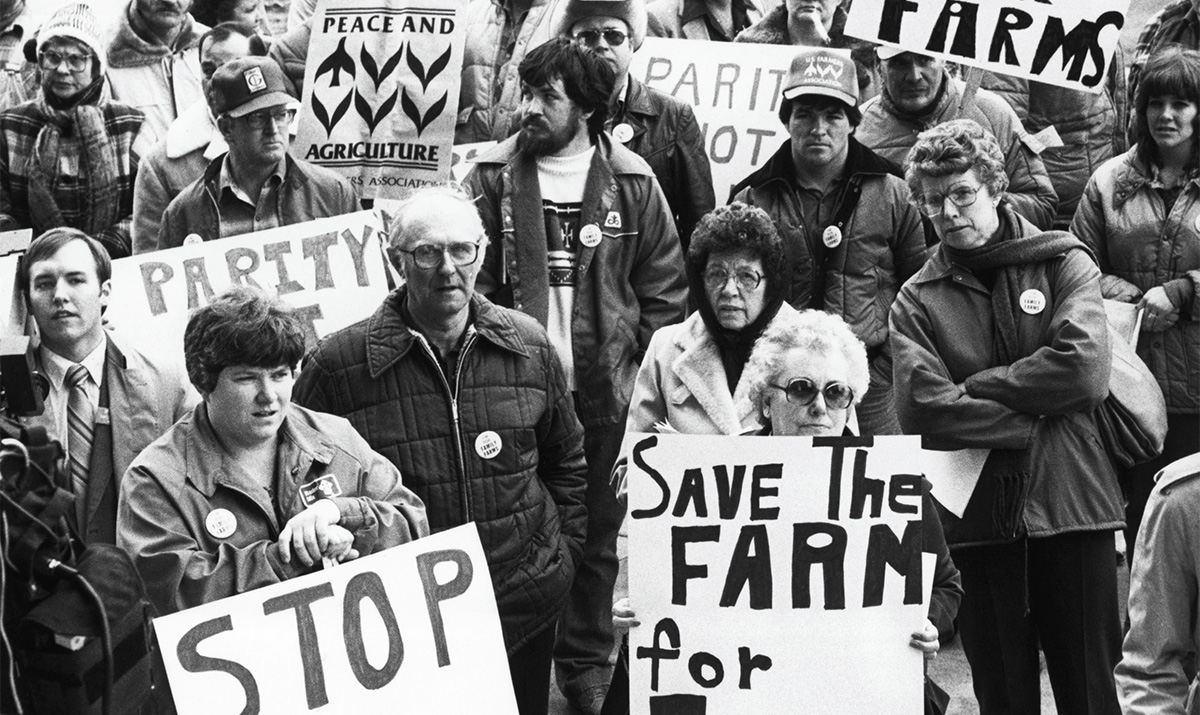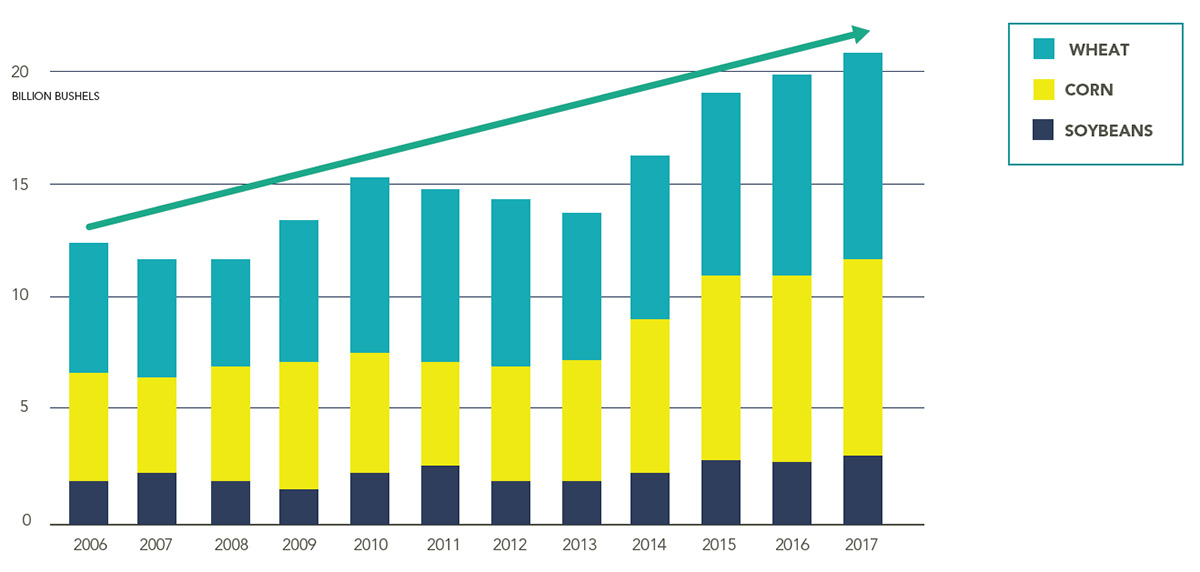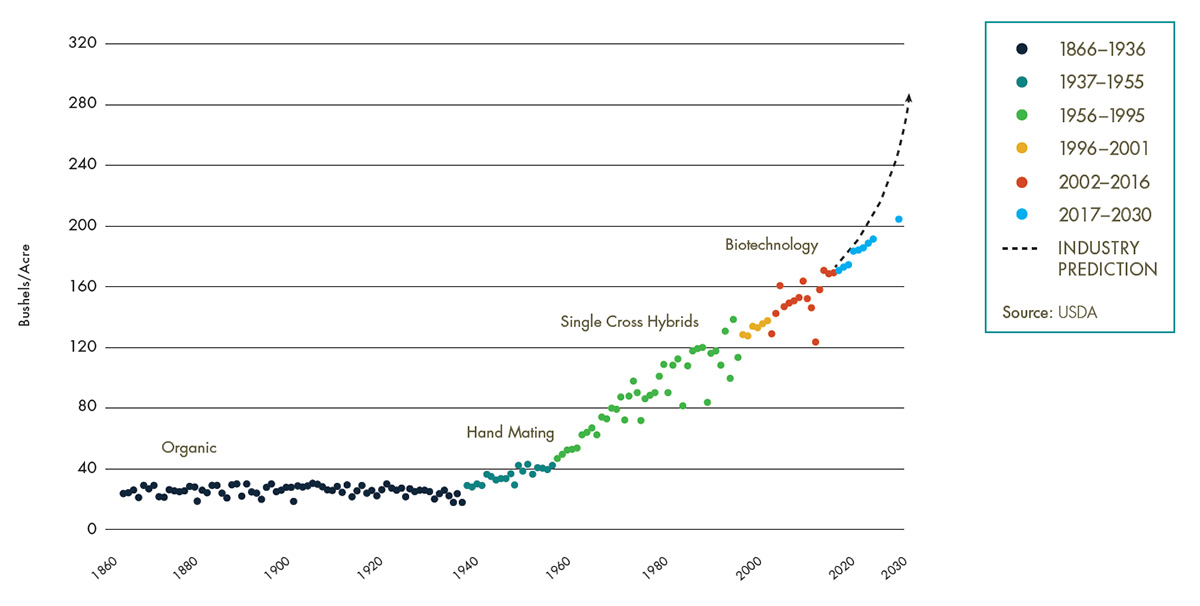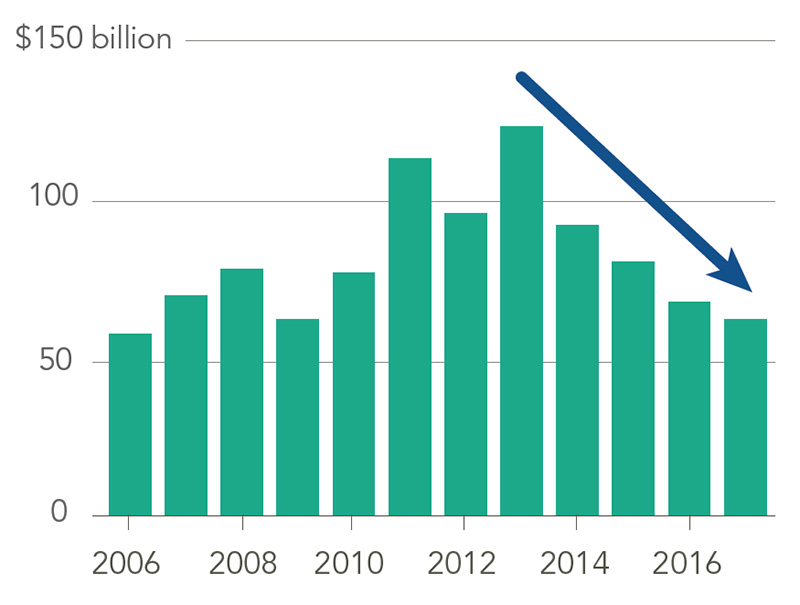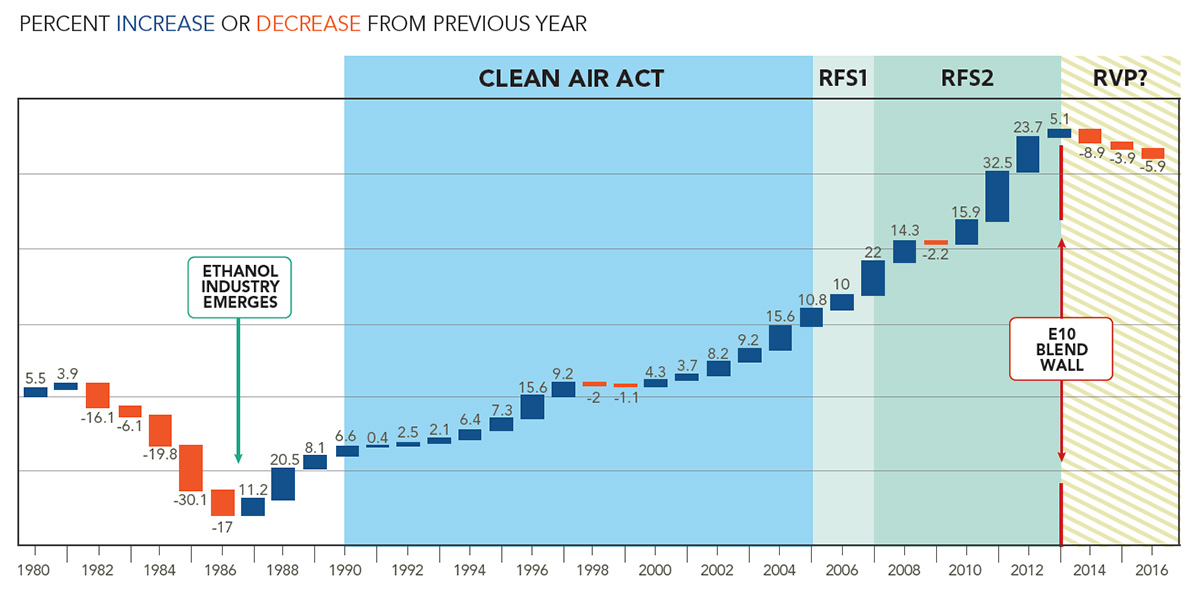March 16, 1983, Des Moines, Iowa: About 100 people — farmers, members of their families and supporters — gather to listen to speakers from the Iowa Farm Unity Coalition at a rally at the state capitol. Farmers are lobbying for minimum prices for corn and soybeans and for a moratorium on farm foreclosures. Bettmann/Getty Images
For American farmers, 1979 was a pivotal year. While most experts did not see it coming, it was a year that, by many accounts, marked the start of the 1980s agricultural crisis, the worst six-year stretch for the ag industry since the Great Depression.
It was a year where farm profits declined, farm debt increased, farm exports plateaued and interest rates increased. At one point during a single week in 1985, an estimated 250 farms closed per hour.
Industry experts say there are many parallels that lead from the farm industry in 1979 to what is being seen today.
The fundamentals that drove farming in the 1980s are also driving farming today, says Jason Henderson, former Vice President at the Federal Reserve bank of Kansas City and current Associate Dean in the College of Agriculture and Director of Purdue Extension at Purdue University.
"Profits are declining, exports have started to plateau, debt is on the rise, they’re starting to raise interest rates," says Henderson. "Signs point to a downturn. We can get through it, but we have to do something about it now, or it’s going to mean tough times again for sure."
While ag industry experts differ on their predictions for farming’s outlook for the next several years, they agree on one thing: Biofuels are the main factor that has helped save the industry so far — and they are the only solution to today’s agricultural downturn.
Policymakers point to the importance of backing the biofuels industry through work like continued support of the Renewable Fuel Standard, or RFS, the law that requires biofuels to be blended into the U.S. supply of gasoline and diesel fuel, and efforts to find a fix to the Reid Vapor Pressure (RVP) waiver, which places limits on E15 sales during summer months. The stakes are high: Oil interests continue to undermine biofuels in order to eliminate their competition at U.S. gas stations.
Today’s economic climate further underscores the important role of biofuels to mitigate an impending ag crisis, says Bill Northey, the Iowa Secretary of Agriculture.
"We can’t control all of the factors, but one thing we can control is ethanol production," says Northey, a fourth-generation farmer. "We’d have a full-blown ‘80s ag crisis today if we didn’t have ethanol. We need E15, need higher blends, need higher sales of ethanol. We’ve seen the benefits of this in the past; we need it now, and it can be a difference between whether we suffer through something like the ‘80s again."
Ray Gaesser, 64, grew up on a small farm in Indiana. He got married and bought his own farm in Corning, Iowa, in 1978, and he knows all about those tough times during the ‘80s. He and his wife, Elaine, were in their mid-20s when the downturn hit hard.
"Like a lot of farmers today, we didn’t think we were overleveraged in ’79 and ’80," says Gaesser. "But it turned out we were when our land value dropped to a third of what we paid for it. Suddenly, we had no net worth."
Today, Gaesser farms 6,000 acres — half corn, half soybeans. While he’s cautiously optimistic about the next few years, he’s not taking on any more debt, not buying any new land and not buying any new equipment.
"I know a lot of farmers doing the same thing," he says. "Today definitely feels like 1980 or so. The interest rates may be lower, but that could change quickly. And it takes a lot more money to farm today — maybe three or four times as much per acre — as it did back then."
At 75, Jerry Losure still occasionally uses the first tractor he ever bought on his own, a 1966 John Deere 4020. "It runs like a top," says Losure, who grows corn, soybeans and wheat on his farm near Marion, Ind., a mile from where he grew up. After farming for 60 years, Losure fears that too many farmers — especially younger farmers — have invested too much in newer equipment.
"I was fortunate in the ‘80s," he says.
"I had working debt, but not the kind of debt that gets you in big trouble. We saw people a few years ago, when corn and bean prices went too high, buying equipment based on those prices. Now, land and machinery has gone up and hasn’t come back down, and prices are falling. A lot of those new farmers aren’t going to survive if the price of corn doesn’t go up."
One of those soon-to-be-new full-time farmers is Losure’s daughter, Amy Beebe, who plans to take over the family farm soon.
After stints as a teacher and semi-driver, Beebe says she felt compelled to return to the family farm. "I’ve known probably since I could know anything about myself that farming feels right," she says. "It doesn’t get any better than seeing my kids (10, 8 and 5) getting involved in something so important for America. I’m optimistic about our work ethic and desire. I’m partially optimistic about the next few years for the ag industry."
When Marion, Ohio, corn and soybean farmer Roy Loudenslager went through the 1980s ag crisis, he talked to someone who had been through the same thing: His grandfather had been a farmer during the Great Depression.
"He paid $300 an acre and saw it drop to $100," says Loudenslager, who formed a farming partnership with his brother in 1953, and now has a grandson helping on the farm. "For me, land prices went from $3,000 an acre in the ‘80s to less than half that. You’ve always got to be prepared for hard times ahead, and there could certainly be hard times ahead if they don’t do some things now to make sure the ‘80s don’t happen again."
While all four farmers also see differences between the 1980s and today — with lower inflation and less overall debt — all four point to one positive today that wasn’t prevalent in the early ‘80s: biofuels.
In 1979, corn yields reached historic highs, with an average of 109 bushels per acre for a total of 7.5 billion U.S. bushels.
This year is expected to match or surpass 2016’s record-setting totals of 170 bushels per acre and 14.5 billion total bushels.
"In the ‘80s, we were getting 110 bushels," says Gaesser. "Now we consistently make 190 to 210. We’ve almost doubled our yields. Think of all the corn back then, just sitting around, not able to be sold. Today, ethanol has been a godsend. That would have helped a lot in the ‘80s, and it’s one of the lessons we’ve hopefully learned for today. Now the question is whether anyone will do anything about it."
POLICY SOLUTION
U.S. Sen. Chuck Grassley is someone trying to do something about it. The longtime senator from Iowa has a history as a proponent of ag issues, which should come as no surprise for a guy who still lives within a few miles of the New Hartford, Iowa, farmhouse where he was born in 1933. He still owns a corn and soybean farm there.
"It’s because of ethanol that we’re able to keep the corn price as high as it is," says Grassley. "We have to do more things in Washington to support the ethanol industry."
Those things, according to Grassley, include continued support of the RFS; freer export of biofuels; and an overhaul of RVP regulations.
"If crop prices continue below the price of production, next year is going to be very, very bad," he says. "What we don’t have in price we made up in bushels to sell because of outstanding production last year. That’s why we have to keep a very, very vigorous and strong ethanol industry."
POET’s legislative and political priorities for 2017 follow suit with the initiatives noted by Grassley. Those priorities are to support growth for biofuels infrastructure under a strong RFS, remove barriers to consumer fuel choices with a RVP fix, and open new markets for U.S. exports and trade of biofuels. "Our policy efforts have been focused most recently on working to add RVP relief in the domestic market. The statute in the Clean Air Act is listed as the biggest barrier to fuel retailers offering more clean-burning E15 to customers. Offering E15 year-round would bring tremendous value to our industry, consumers and the environment. We also need RVP relief to realize the promise of cellulosic biofuels, which we’re on the verge of bringing online. In addition, while U.S. corn exports remain stagnant, there continue to be opportunities to open new markets for ethanol exports. We continue to
support efforts to educate foreign policymakers about the benefits of biofuels," says Kyle Gilley, Senior Vice President of External Affairs & Communications, POET.
EXPERTS PREDICT DIRE FORECASTS FOR U.S. CORN EXPORTS
While many argue that exporting more corn would be the preferred way to alleviate that oversupply, the market for U.S. corn exports has not kept pace with farmers’ record-high corn yields — and industry experts continue to have dire forecasts for the U.S. corn export market. "We believe that exports will continue to decline for the U.S. farmer to the point where they could lose 300 to 500 million bushels of export market share," said Dean Watson, President of POET Grain. This year Watson estimates more than 2.2 billion bushels will go into the export market.
Global Corn, Soybeans and Wheat Surplus: It’s not just happening in the U.S. This is happening around the world. Places like Argentina, Ukraine, Brazil and others are playing a larger role in the export market. Global supplies of corn, soybeans and wheat have risen to record levels. In the last four years, the global grain carryout has gone up 50 percent, from 14 billion bushels to 21 billion bushels.
Historically, the export market has served as a flushing mechanism for excess corn. Since 2000, the U.S. has exported on average 1.9 billion bushels of corn. That number has been fairly static for the last 30 years even as corn harvest yields per acre have steadily increased. Ethanol consumption has served as the mechanism to soak up the grain surplus above the historical export volumes. "As ethanol consumption increased, it was able to increase along with the gains the farmer has made. Although ethanol production has leveled off, the gains that the farmer has made have not stopped. Despite no new demand, yields continue to increase," Watson said. For example, since the 2006 to 2010 time period, yields jumped from 152 to an average of 171 bushels per acre in 2016. That’s an extra 1.71 billion new bushels of corn in the U.S.
Additionally, international players on the export market for corn and soybeans are pushing out the U.S. farmer due to their lower cost of production competitive advantage.
"The typical market for the incremental bushel has been exports. As countries like Brazil, Argentina, Ukraine and Russia have increased their ability to produce, the export market has no longer become a viable option for U.S. agriculture at the historical volume levels. That’s why you see inventories growing dramatically and why values are plummeting dramatically. Unless we find a way to keep pace with the farmers’ ability to grow corn, the grain values on the farm will get to the point where people can’t afford to farm," Watson said.
Amy Beebe felt compelled to return to the family farm after spending time as a teacher and semi-driver. (photo by Jayne Rohlfing | besweetlight.com)
While historical data shows that commodity exports will remain limited, the upside is that value-added products like DDGS (distillers dried grains with solubles, a nutritious animal feed) and corn oil have great potential for opportunities in overseas markets.
For Jim Miller, President of Agriculture and Biofuel Policy Consulting, exporting ethanol — and ethanol co-products — represents a relatively untapped export opportunity for the farm industry.
"Ethanol exports provide additional market opportunities for U.S. corn producers, create additional jobs, primarily in rural America, and represent a significant opportunity to add additional value to corn and other ethanol feedstocks," says Miller, who has more than 35 years of work experience on ag, energy, trade and policy issues. "The co-products of U.S. ethanol production, such as DDGS and corn oil, represent important additional value added opportunities for U.S. agriculture domestically and in overseas markets."
TODAY’S INDICATORS PARALLEL THOSE OF THE 1970s, 1980s
While ag industry experts differ on their predictions for farming’s next few years, key indicators and reports from institutions including the United States Department of Agriculture (USDA) are oddly similar to the late 1970s and early ‘80s.
"The past year has been a disappointing one for farmers," wrote the Kansas City Fed in 1982. "During 1981, farmers experienced the second year in a row of sharply depressed farm income."
U.S. Corn Yields: Precision farming and planting more plants per acre are increasing yields. The boom years in the 2000s led to improved efficiency as farmers bought new equipment and seed companies invested in better technology. Corn production is predicted to nearly double in the next 15 years.
U.S. farm income continues to drop. The United States Department of Agriculture projects 2017’s farm real estate debt will increase by 5 percent and reach a historic high of $240.7 billion. Net U.S. farm income is estimated to be $62.3 billion this year, down from $123 billion in 2013.
A report from the same institution in April of this year echoed similar sentiments: "Persistent declines in farm income have remained a primary driver of reduced lending in the farm sector. Revenue from the production of most agricultural commodities is expected to decline again in 2017."
The USDA projects 2017’s farm real estate debt will increase by 5 percent and reach a historic high of $240.7 billion. Net U.S. farm income is estimated to be $62.3 billion this year, down from $123 billion in 2013.
A recent article from The Wall Street Journal, "The Next American Farm Bust Is Upon Us," notes that "American farmers’ incomes will drop 9 percent in 2017 ... extending the steepest slide since the Great Depression into a fourth year."
At 82, John Block, who served as U.S. Secretary of Agriculture from 1981-86, still owns his 4,000-acre family farm in Illinois, where, he says, his "roots are embedded in that black soil."
Block saw firsthand the complexities of the ‘80s farm crisis.
"There are certainly parallels today," says Block, who now serves as a lobbyist focusing on ag issues. "But if we didn’t have the money that’s been pumped into corn by ethanol, we’d be in more trouble than we are today. In the ‘80s, ethanol was just starting to come into play, but that would definitely have helped us. The question is whether we will act now on what we learned, before it’s too late."
In hindsight, acting too late describes the ag industry in 1979, when too many experts, too many farmers and too many policymakers overlooked — or underestimated — those warning signs like ever-increasing yields, falling profits, growing debt and rising interest rates.
"There’s no question, if prices remain where they are, we will see some farmers unable to compete in this environment," says Chuck Conner, President of the National Council of Farmer Cooperatives. "If something isn’t done, we’ll lose more farmers."
Corn production, according to most industry experts, will continue to rise, as Precision Ag practices and ever-evolving technology drive yields even higher. Some experts are predicting nationwide averages of 300-bushel yields within 15 years.
Farmers Jerry Losure, Roy Loudenslager and Ray Gaesser — and many of those policymakers — lived through the ‘80s ag crisis, and remember it vividly: the foreclosures, the farm auctions, and friends and family members facing bankruptcy.
Jerry’s daughter will be taking over his farm soon. Roy’s grandson recently came back to work on his farm. Ray’s son works with him full-time.
"Did we learn those lessons from the 1980s or not?" asks Ray, who sells every bushel of corn he grows to the POET Biorefining — Corning in Corning, Iowa. "We didn’t seem to do enough then when we should have. Will we be looking back in five years saying they could have done this and that but no one did? If we do, that will be a shame."
Iowa Land Value Change: A three, soon-to-be four-year decline in land values is significant. If we look at the last three decades, there’s only one other time we’ve seen this happen: the 1980s farm crisis.
